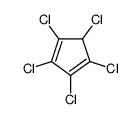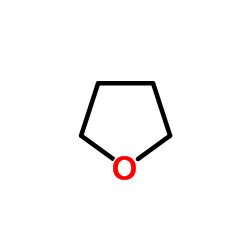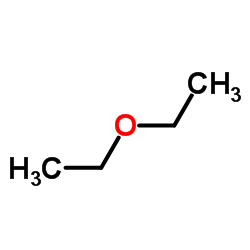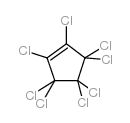2227-17-0
| 中文名 | 除螨灵 |
|---|---|
| 英文名 | dienochlor |
| 中文别名 | 得氯蹒 |
| 英文别名 |
decachlorobiscyclopentadienyl
Pentac WP BIS(PENTACHLOROCYCLOPENTADIENYL) EINECS 218-763-5 Hooker hrs-16 Decachlorobi-2,4-cyclopentadien-1-yl PENTAC 1,1’,2,2’,3,3’,4,4’,5,5’-decachlorobi(cyclopenta-2,4-diene) HRS 16A Dienochlor Dienochlore 1,2,3,4,5-pentachloro-5-(1,2,3,4,5-pentachlorocyclopenta-2,4-dien-1-yl)cyclopenta-1,3-diene perchloro-1,1’-bicyclopenta-2,4-diene Hooker HRS 1654 MFCD00019272 1,1’,2,2’,3,3’,4,4’,5,5’-decachlorobi-2,4-cyclopentadien-1-yl Decachlor Pentac SP |
| 密度 | 1.94g/cm3 |
|---|---|
| 沸点 | 455.6ºC at 760mmHg |
| 分子式 | C10Cl10 |
| 分子量 | 474.63700 |
| 闪点 | 229.7ºC |
| 精确质量 | 469.68900 |
| LogP | 7.72560 |
| 蒸汽压 | 4.69E-08mmHg at 25°C |
| 折射率 | 1.662 |
| 储存条件 | 库房通风低温干燥; 与食品原料分开储运 |
| 稳定性 | 黄褐色结晶固体。熔点122-123℃,蒸气压为1.33×10-3Pa。不溶于水,易溶于芳烃。对含水酸碱稳定,但高温条件下或阳光紫外光照射下都会失去活性,130℃下6h活性降低50%。燃烧产生有毒氯化物气体 |
| 分子结构 | 1、 摩尔折射率:90.43 2、 摩尔体积(cm3/mol):244.3 3、 等张比容(90.2K):673.9 4、 表面张力(dyne/cm):57.8 5、 极化率(10-24cm3):35.84 |
| 计算化学 | 1.疏水参数计算参考值(XlogP):6.3 2.氢键供体数量:0 3.氢键受体数量:0 4.可旋转化学键数量:1 5.互变异构体数量:无 6.拓扑分子极性表面积0 7.重原子数量:20 8.表面电荷:0 9.复杂度:530 10.同位素原子数量:0 11.确定原子立构中心数量:0 12.不确定原子立构中心数量:0 13.确定化学键立构中心数量:0 14.不确定化学键立构中心数量:0 15.共价键单元数量:1 |
|
Section1. IDENTIFICATION OF THE SUBSTANCE/MIXTURE Product identifiers Product name: Dienochlor CAS-No.: 2227-17-0 Relevant identified uses of the substance or mixture and uses advised against Identified uses: Laboratory chemicals, Manufacture of substances Section2. HAZARDS IDENTIFICATION Classification of the substance or mixture Classification according to Regulation (EC) No 1272/2008 [EU-GHS/CLP] Acute toxicity, Oral (Category 4) Eye irritation (Category 2) Acute aquatic toxicity (Category 1) Classification according to EU Directives 67/548/EEC or 1999/45/EC Harmful if swallowed. Label elements Labelling according Regulation (EC) No 1272/2008 [CLP] Pictogram Signal wordWarning Hazard statement(s) H302Harmful if swallowed. H319Causes serious eye irritation. H400Very toxic to aquatic life. Precautionary statement(s) P273Avoid release to the environment. P305 + P351 + P338IF IN EYES: Rinse cautiously with water for several minutes. Remove contact lenses, if present and easy to do. Continue rinsing. Supplemental Hazardnone Statements According to European Directive 67/548/EEC as amended. Hazard symbol(s) R-phrase(s) R22Harmful if swallowed. S-phrase(s) S22Do not breathe dust. S24Avoid contact with skin. Other hazards - none Section3. COMPOSITION/INFORMATION ON INGREDIENTS Substances Formula: C10Cl10 Molecular Weight: 474,6 g/mol ComponentConcentration Dienochlor CAS-No.2227-17-0- EC-No.218-763-5 Section4. FIRST AID MEASURES Description of first aid measures General advice Consult a physician. Show this safety data sheet to the doctor in attendance. If inhaled If breathed in, move person into fresh air. If not breathing, give artificial respiration. Consult a physician. In case of skin contact Wash off with soap and plenty of water. Consult a physician. In case of eye contact Rinse thoroughly with plenty of water for at least 15 minutes and consult a physician. If swallowed Never give anything by mouth to an unconscious person. Rinse mouth with water. Consult a physician. Most important symptoms and effects, both acute and delayed To the best of our knowledge, the chemical, physical, and toxicological properties have not been thoroughly investigated. Indication of any immediate medical attention and special treatment needed no data available Section5. FIREFIGHTING MEASURES Extinguishing media Suitable extinguishing media Use water spray, alcohol-resistant foam, dry chemical or carbon dioxide. Special hazards arising from the substance or mixture Carbon oxides, Hydrogen chloride gas Advice for firefighters Wear self contained breathing apparatus for fire fighting if necessary. Further information no data available Section6. ACCIDENTAL RELEASE MEASURES Personal precautions, protective equipment and emergency procedures Use personal protective equipment. Avoid dust formation. Avoid breathing vapors, mist or gas. Ensure adequate ventilation. Evacuate personnel to safe areas. Avoid breathing dust. Environmental precautions Prevent further leakage or spillage if safe to do so. Do not let product enter drains. Discharge into the environment must be avoided. Methods and materials for containment and cleaning up Pick up and arrange disposal without creating dust. Sweep up and shovel. Keep in suitable, closed containers for disposal. Reference to other sections For disposal see section 13. Section7. HANDLING AND STORAGE Precautions for safe handling Avoid contact with skin and eyes. Avoid formation of dust and aerosols. Provide appropriate exhaust ventilation at places where dust is formed. Conditions for safe storage, including any incompatibilities Store in cool place. Keep container tightly closed in a dry and well-ventilated place. Specific end uses no data available Section8. EXPOSURE CONTROLS/PERSONAL PROTECTION Control parameters Components with workplace control parameters Exposure controls Appropriate engineering controls Handle in accordance with good industrial hygiene and safety practice. Wash hands before breaks and at the end of workday. Personal protective equipment Eye/face protection Safety glasses with side-shields conforming to EN166 Use equipment for eye protection tested and approved under appropriate government standards such as NIOSH (US) or EN 166(EU). Skin protection Handle with gloves. Gloves must be inspected prior to use. Use proper glove removal technique (without touching glove's outer surface) to avoid skin contact with this product. Dispose of contaminated gloves after use in accordance with applicable laws and good laboratory practices. Wash and dry hands. The selected protective gloves have to satisfy the specifications of EU Directive 89/686/EEC and the standard EN 374 derived from it. Body Protection Complete suit protecting against chemicals, The type of protective equipment must be selected according to the concentration and amount of the dangerous substance at the specific workplace. Respiratory protection For nuisance exposures use type P95 (US) or type P1 (EU EN 143) particle respirator.For higher level protection use type OV/AG/P99 (US) or type ABEK-P2 (EU EN 143) respirator cartridges. Use respirators and components tested and approved under appropriate government standards such as NIOSH (US) or CEN (EU). Section9. PHYSICAL AND CHEMICAL PROPERTIES Information on basic physical and chemical properties a) AppearanceForm: crystalline Colour: tan b) Odourno data available c) Odour Thresholdno data available d) pHno data available e) Melting point/freezingMelting point/range: 122 - 123 °C point f) Initial boiling point and 250 °C at 1.013 hPa boiling range g) Flash pointno data available h) Evaporation rateno data available i) Flammability (solid, gas) no data available j) Upper/lowerno data available flammability or explosive limits k) Vapour pressureno data available l) Vapour densityno data available m) Relative densityno data available n) Water solubilityno data available o) Partition coefficient: n- no data available octanol/water p) Autoignitionno data available temperature q) Decompositionno data available temperature r) Viscosityno data available s) Explosive propertiesno data available t) Oxidizing propertiesno data available Other safety information no data available Section10. STABILITY AND REACTIVITY Reactivity no data available Chemical stability no data available Possibility of hazardous reactions no data available Conditions to avoid no data available Incompatible materials Strong oxidizing agents Hazardous decomposition products Other decomposition products - no data available Section11. TOXICOLOGICAL INFORMATION Information on toxicological effects Acute toxicity LD50 Oral - rat - 1.200 mg/kg LD50 Dermal - rat - > 5.000 mg/kg Skin corrosion/irritation Serious eye damage/eye irritation Eyes - rabbit - Mild eye irritation - 24 h Respiratory or skin sensitization no data available Germ cell mutagenicity no data available Carcinogenicity IARC:No component of this product present at levels greater than or equal to 0.1% is identified as probable, possible or confirmed human carcinogen by IARC. Reproductive toxicity no data available Specific target organ toxicity - single exposure no data available Specific target organ toxicity - repeated exposure no data available Aspiration hazard no data available Potential health effects InhalationMay be harmful if inhaled. May cause respiratory tract irritation. IngestionHarmful if swallowed. SkinMay be harmful if absorbed through skin. May cause skin irritation. EyesCauses eye irritation. Signs and Symptoms of Exposure To the best of our knowledge, the chemical, physical, and toxicological properties have not been thoroughly investigated. Additional Information RTECS: DT8225000 Section12. ECOLOGICAL INFORMATION Toxicity Toxicity to fishLC50 - Oncorhynchus mykiss (rainbow trout) - 0,05 mg/l - 96 h Toxicity to daphnia and EC50 - Daphnia magna (Water flea) - 1,2 mg/l - 48 h other aquatic invertebrates Persistence and degradability no data available Bioaccumulative potential no data available Mobility in soil no data available Results of PBT and vPvB assessment no data available Other adverse effects Very toxic to aquatic life. no data available Section13. DISPOSAL CONSIDERATIONS Waste treatment methods Product Offer surplus and non-recyclable solutions to a licensed disposal company. Dissolve or mix the material with a combustible solvent and burn in a chemical incinerator equipped with an afterburner and scrubber. Contaminated packaging Dispose of as unused product. Section14. TRANSPORT INFORMATION UN number ADR/RID: 3077IMDG: 3077IATA: 3077 UN proper shipping name ADR/RID: ENVIRONMENTALLY HAZARDOUS SUBSTANCE, SOLID, N.O.S. (Dienochlor) IMDG: ENVIRONMENTALLY HAZARDOUS SUBSTANCE, SOLID, N.O.S. (Dienochlor) IATA:Environmentally hazardous substance, solid, n.o.s. (Dienochlor) Transport hazard class(es) ADR/RID: 9IMDG: 9IATA: 9 Packaging group ADR/RID: IIIIMDG: IIIIATA: III Environmental hazards ADR/RID: yesIMDG Marine pollutant: yesIATA: yes Special precautions for user Further information EHS-Mark required (ADR 2.2.9.1.10, IMDG code 2.10.3) for single packagings and combination packagings containing inner packagings with Dangerous Goods > 5L for liquids or > 5kg for solids. SECTION 15 - REGULATORY INFORMATION N/A SECTION 16 - ADDITIONAL INFORMATION N/A |
|
毒理学数据: 口服- 大鼠 LD50: 1200 毫克/ 公斤; 口服- 小鼠 LD50: 16900 毫克/ 公斤 CHEMICAL IDENTIFICATION
HEALTH HAZARD DATAACUTE TOXICITY DATA
MUTATION DATA
|
| 符号 |


GHS07, GHS09 |
|---|---|
| 信号词 | Warning |
| 危害声明 | H302-H410 |
| 警示性声明 | P301 + P312 + P330 |
| 个人防护装备 | dust mask type N95 (US);Eyeshields;Gloves |
| 危害码 (欧洲) | Xn: Harmful; |
| 风险声明 (欧洲) | 22 |
| 安全声明 (欧洲) | S22;S24 |
| 危险品运输编码 | UN 2761 |
| RTECS号 | DT8225000 |
| 危险类别 | 6.1(a) |
| 海关编码 | 2903890090 |
| 上游产品 10 | |
|---|---|
| 下游产品 3 | |
| 海关编码 | 2903890090 |
|---|---|
| 中文概述 | 2903890090. 其他环烷烃、环烯烃或环萜烯烃的卤化衍生物. 增值税率:17.0%. 退税率:13.0%. 监管条件:无. 最惠国关税:5.5%. 普通关税:30.0% |
| 申报要素 | 品名, 成分含量, 用途 |
| Summary | 2903890090. halogenated derivatives of cyclanic, cyclenic or cyclotherpenic hydrocarbons. VAT:17.0%. Tax rebate rate:13.0%. . MFN tariff:5.5%. General tariff:30.0% |













